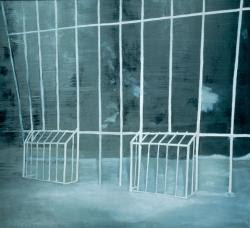
Luc Tuymans Exhibits for the First Time in Spain at Centro de Arte Contemporáneo Málaga
MALAGA.- “Art is not derived from art. Art derives from reality.” Tuymans’s words constitute a statement of intent and a clear explanation of the nature of his work in which he aims to evoke and insinuate but in which it is the viewer’s responsibility to fill in the gaps that have been deliberately left there and to construct his or her own narrative. Tuymans is a committed artist and his work engages with events that have marked contemporary society despite the existence of a collective desire for amnesia that aims to forget or to distort these events within the context of a society that at times seems closer to the deceptive reality presented by Aldous Huxley in Brave New World.
The CAC Málaga is presenting Retratos y vegetación, the first exhibition devoted to Luc Tuymans in Spain. It comprises a selection of 16 oil paintings of different sizes that reveal the technique that has made Tuymans a key reference point for a new generation of figurative artists for whom painting is the optimum means of expression, contrary to those who still consider it a conservative one that contradicts the heterogeneous nature of contemporary art. Fluid brushstrokes (Soldier, 1999), diffused lines (The Rumour, 2001) and muted colours (Singing Flowers, 2008) are used to envelop the figures in a tense silence in the manner of a metaphor for the fog that seems to shroud historical and collective memory on occasions.
Tuymans has focused on painting in his work since the mid-1980s. However, he abandoned this medium for a period in order to focus entirely on filmmaking. That passing phase left its mark on his subsequent output, which he has meticulously created through preparatory drawings, photographs, slides, stills from films and a wide range of techniques that have functioned to enrich his compositions.
For Fernando Francés, director of the CAC Málaga: “Many people have described Tuymans’s painting as pessimistic, perhaps due to the violent, crude force behind it, which he uses as a vehicle to dissect reality in a manner devoid of grandiloquence and moralising intent. It is clear that we are in the presence of one of the figures most admired by both established artists such as Alex Katz and by younger ones for whom Tuymans is now one of the legendary names of international painting.”
In Tuymans’s paintings ideas are not explicitly revealed but rather emerge through concealed allusions and indirect references. He offers us apparently innocuous images but ones charged with intensity, as a result of which they generate disquiet and disturb the viewer. Thus behind the imperturbable gaze of the figure in Secrets (1990) lies Albert Speer, architect of the Third Reich and armaments minister under the Nazi regime. The restrained way that Tuymans depicts Speer, with his eyes closed, encourages us to find out the secrets referred to in the title. Evidence (2005) depicts the unidentified victim of a Russian serial killer. The diffused brushwork and almost unrecognisable face reveal Tuymans’s aims of insinuating rather than showing and of referring to memory. Portrait (2000) refers to the photographs of dead people that are used to announce funerals in Belgium.
Luc Tuymans (born Mortsel, Belgium, 1958) is heir to the extensive northern European pictorial tradition and Jan van Eyck is one of the artists whom he most admires. Other artists particularly esteemed by Tuymans include Velázquez, El Greco and Zurbarán and their influence is evident in many of his works. Tuymans’s paintings have been exhibited in leading museums and art centres such as the MoMA, New York, Tate Modern, London, the Centre Georges Pompidou, Paris, and the San Francisco Museum of Modern Art.

Artwork shown: Secrets, 1990. Oil on canvas, 52×37cm; Within,
2001. Oil on Canvas, 223 x 243cm

